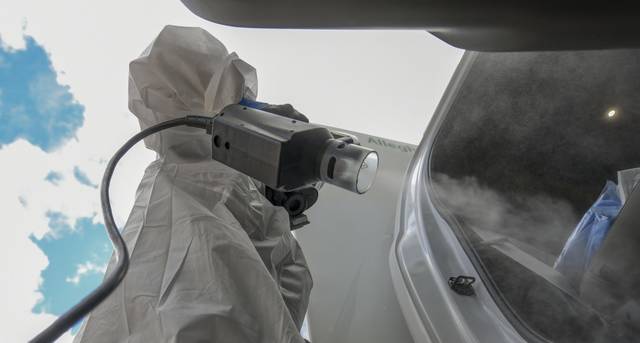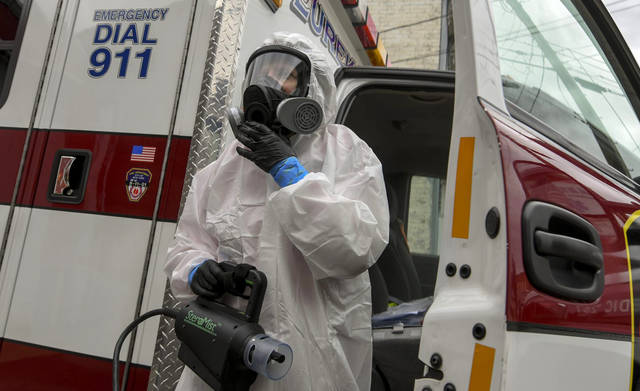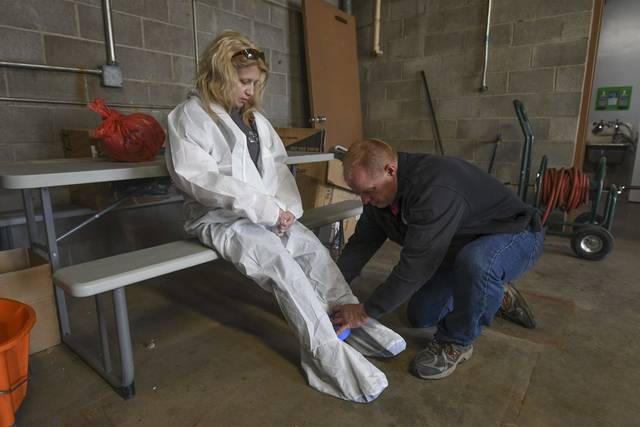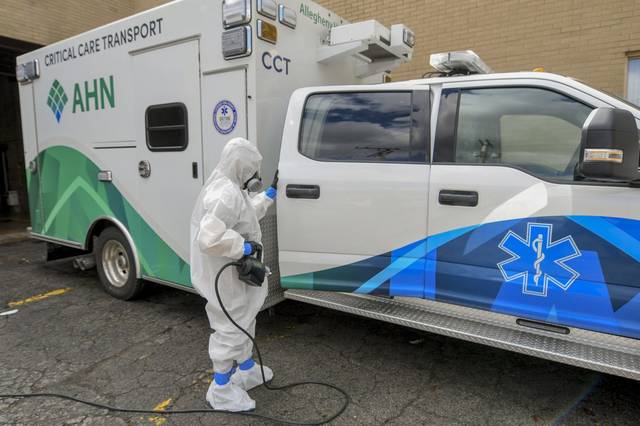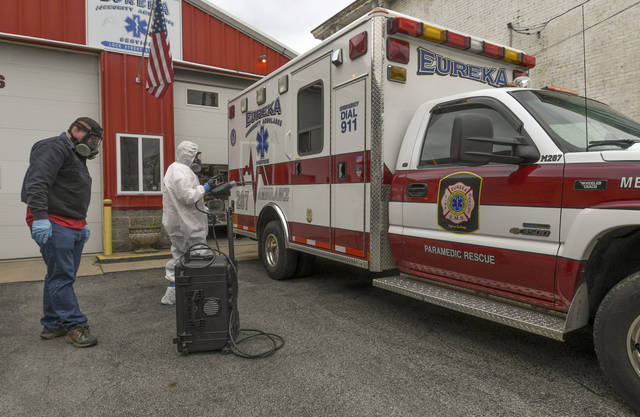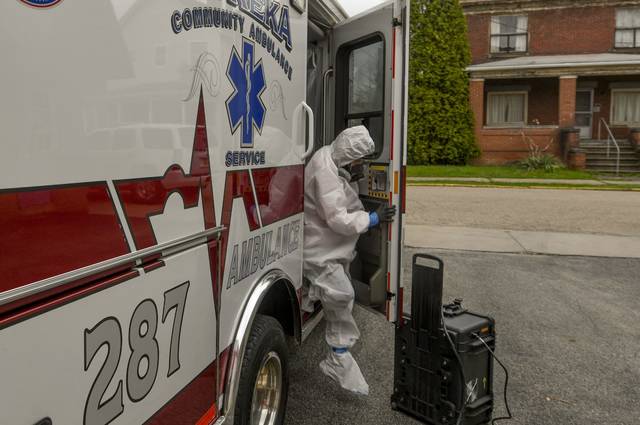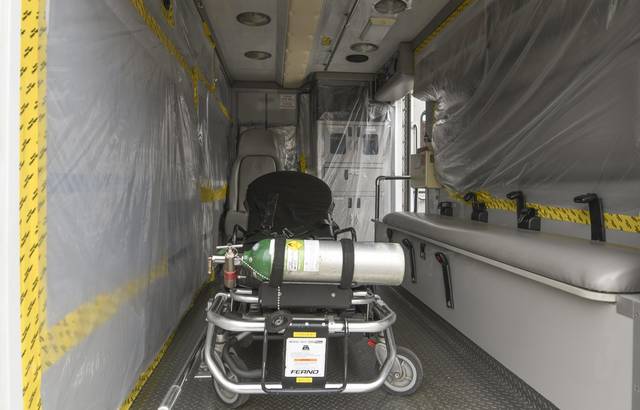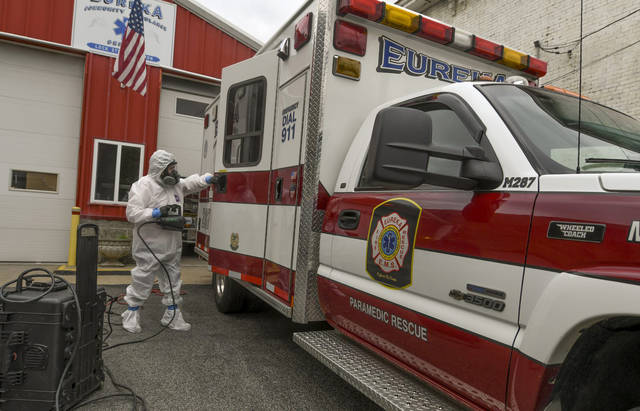High-speed disinfecting process proves invaluable to Western Pa. ambulance crews
As the coronavirus continues to spread and send many patients to the hospital, ambulance crews are balancing a thorough disinfection process with getting back on the road as quickly as possible.
It’s a situation that has led to an uptick in business for cleaning and restoration companies that have a specialized disinfection process in their repertoire, such as Pittsburgh-based G.S. Jones Restoration and Consulting.
The cleaner, called SteraMist, can get the disinfection process done within 30 minutes.
“That’s the key,” said Lloyd Lane, director of business development for G.S. Jones.
The process was developed by the U.S. Defense Department in the aftermath of 9/11 in response to possible anthrax attacks. Lane explained the process: A handheld spray unit ionizes a solution of hydrogen peroxide into a mist, and the ionized hydrogen peroxide activates when it lands.
The solution is approved by the federal Environmental Protection Agency to kill the likes of Ebola, MRSA and coronaviruses — including the one that causes covid-19, Lane said.
The mist is safe for just about any surface, including electronics, which makes it particularly useful for disinfecting ambulances, office buildings and hospitals.
Lane said the service has become more in demand since covid-19 began its rapid-fire spread across the state and country.
“I don’t think we’re even to the point of it slowing down yet,” Lane said.
Robert Craig and his wife, Monica, who often are the ones doing the disinfecting, agreed.
“We’ve been working around the clock, especially with EMS, first responders and some office buildings,” Robert Craig said.
He said it’s mostly him and his wife who do the cleaning, but if it’s a large building, they have to limit the amount of time they’re potentially exposed. When that happens, they call in backup. He said there are around six people who clean.
If the cleaning is for a suspected case of covid-19, every precaution is taken. One of the pair dons a biohazard-type suit and a full respirator.
From there, they spray the outside of the ambulance from door handles to running boards, then head inside.
“When she’s done spraying,” Craig said of his wife, “I spray her down, too.”
There’s no real clean-up process. For an ambulance or other first responder vehicle, Craig said they suggest the vehicle’s heat run for 10 to 15 minutes after the mist has settled. After that, it can go right back into service.
“Within half an hour of when we get there, they’re ready to go,” he said.
That’s one of the biggest pluses, said Rich Heuser, chief of Eureka Fire Rescue EMS in Tarentum.
“Hopefully we never get to the saturation levels New York City is experiencing now,” he said. “When you start getting that many calls and your resources are limited — we don’t have 5,000 ambulances to throw at it — that becomes a big problem.”
He said his station is using a variety of commercial products and services, including G.S. Jones. Some of the products can be kept right on the truck.
“We can decontaminate right at the scene, at the hospital,” Heuser said.
Other emergency service providers said they, too, have increased their cleaning process to the highest degree they can.
In Pittsburgh, the decontamination is being done by two roving “highly infectious disease units,” public safety spokeswoman Cara Cruz said.
She said it normally takes place outside the hospital right after a patient is dropped off.
In Penn Township, paramedics and EMTs are taking an extra 25 minutes after every call to disinfect the ambulance inside and out, from the ceiling and benches to medical equipment and the steering wheel.
“We are doing a much more thorough disinfecting of the ambulances,” said Ed Grant, Penn Township Ambulance director. He said medics put their uniforms in the washer as soon as they’re done with the process.
The previous cleaning process involved only equipment that touched a patient, and they’d wipe down the vehicle just once a day.
Medics have been wearing personal protection equipment on most calls and during every transport, Grant said. When two crews are working, one works out of the ambulance station while the second is based at Penn-Trafford High School in an effort to minimize contact between employees, he said.
Heuser said the beefed-up process is one that will likely stay even after the immediate covid-19 threat has diminished.
“Maybe not quite to the extent we’re doing it right now, but it will definitely be adopted into our normal procedures,” he said. “I used to like to think we were pretty on top of our game — the trucks were seriously decontaminated on a monthly basis or after any type of exposure issue. Oh boy, this is a different world.”
Megan Guza and Renatta Signorini are Tribune-Review staff writers. You can contact Megan at 412-380-8519, mguza@triblive.com or via Twitter @meganguzaTrib. You can contact Renatta at 724-837-5374, rsignorini@triblive.com or via Twitter @byrenatta.
Remove the ads from your TribLIVE reading experience but still support the journalists who create the content with TribLIVE Ad-Free.

